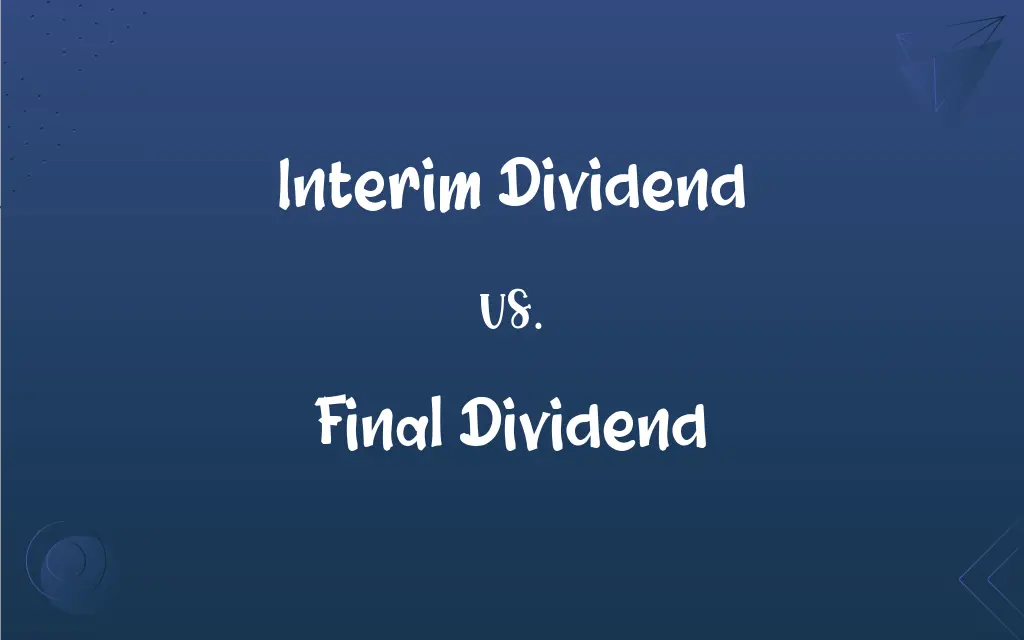Interim Dividend vs. Final Dividend: What's the Difference?
Edited by Aimie Carlson || By Harlon Moss || Published on November 21, 2023
Interim dividend is a dividend paid during a fiscal year, while final dividend is paid at its end.

Key Differences
Interim dividend refers to the dividend distributed by a company during its fiscal year. Final dividend, on the other hand, is the dividend announced after a company closes its books for the year.
An interim dividend is typically declared and paid based on the company's performance in part of the year. The final dividend is based on the entire year's financial performance.
While interim dividend gives shareholders an early return on their investment, the final dividend represents the company's commitment after considering all yearly financial factors.
Decisions about interim dividends are usually based on the projected financial health of a company. Final dividend decisions come after the end of the financial year, ensuring all financial data is considered.
Interim dividend payouts might be lower or fluctuate, reflecting a company's short-term performance. In contrast, final dividends are more stable and are a reflection of the company's overall annual profitability.
ADVERTISEMENT
Comparison Chart
Payment Timing
Paid during the fiscal year.
Paid at the end of the fiscal year.
Basis of Declaration
Based on part-year financial performance.
Based on the entire year's financial performance.
Frequency
Can be more than once a year.
Typically once a year.
Stability
Might fluctuate reflecting short-term performance.
More stable, reflecting overall annual profitability.
Financial Data Considered
Considered based on projected financial health.
All financial data of the year is considered.
ADVERTISEMENT
Interim Dividend and Final Dividend Definitions
Interim Dividend
A dividend declared before the year's final results.
Based on strong Q2 results, the board approved an interim dividend.
Final Dividend
Paid after the full financial data is analyzed.
After reviewing the annual report, the final dividend was set at 8%.
Interim Dividend
Provisional dividend distribution before year-end.
To appease shareholders, an interim dividend was announced.
Final Dividend
A dividend paid post the fiscal year's closure.
After the annual meeting, a final dividend of 10% was declared.
Interim Dividend
Shareholders' early return based on part-year performance.
Encouraged by sales, the company issued an interim dividend.
Final Dividend
Represents the company's overall annual profitability.
The stable growth ensured a generous final dividend to the shareholders.
Interim Dividend
A payout to shareholders during the fiscal year.
The company declared an interim dividend of 5% for the first quarter.
Final Dividend
Announced after considering the entire year's performance.
Based on the yearly profit, the board announced a hefty final dividend.
Interim Dividend
A dividend based on projected financial health.
Seeing growth potential, the company released an interim dividend.
Final Dividend
A shareholder return reflecting the company's yearly commitment.
Investors eagerly awaited the announcement of the final dividend.
FAQs
What is an interim dividend?
An interim dividend is a dividend paid to shareholders during a fiscal year based on part-year performance.
Is the interim dividend based on the entire year's performance?
No, the interim dividend is based on part-year or projected performance.
When is the final dividend declared?
The final dividend is declared after the fiscal year ends, considering the entire year's financial results.
When can shareholders expect interim dividends?
Shareholders can expect interim dividends during the fiscal year, based on the company's decision.
Can a company pay multiple interim dividends?
Yes, a company can declare and pay multiple interim dividends during a fiscal year.
Is the final dividend more stable than the interim dividend?
Typically, final dividends are more stable as they reflect the company's overall annual profitability.
How often is the final dividend paid?
The final dividend is typically paid once a year.
Which dividend reflects the overall annual profitability?
The final dividend reflects a company's overall annual profitability.
What factors influence the declaration of a final dividend?
The final dividend is influenced by the entire year's financial performance and profitability.
Are interim dividends mandatory for companies to declare?
No, declaring an interim dividend is at the discretion of the company.
When are interim dividends typically declared?
Interim dividends are usually declared during the fiscal year based on part-year results or projections.
Which dividend might be lower due to short-term factors?
The interim dividend might be lower or fluctuate due to short-term performance factors.
Which dividend gives an early return to shareholders?
The interim dividend provides an early return to shareholders.
Can the final dividend be skipped by a company?
Yes, if a company doesn't achieve desired financial results, they might skip or reduce the final dividend.
Can both interim and final dividends be declared in the same year?
Yes, a company can declare both interim and final dividends in the same fiscal year.
Which dividend is based on projected financial health?
The interim dividend is based on projected financial health.
Is the final dividend a reflection of the company's commitment?
Yes, the final dividend reflects the company's commitment after considering all yearly financial factors.
Can a company declare multiple final dividends in a year?
No, final dividends are typically declared and paid once after the fiscal year ends.
Does the interim dividend fluctuate frequently?
Interim dividends might fluctuate reflecting a company's short-term performance.
How is the final dividend amount determined?
The final dividend amount is determined after analyzing all financial data of the year.
About Author
Written by
Harlon MossHarlon is a seasoned quality moderator and accomplished content writer for Difference Wiki. An alumnus of the prestigious University of California, he earned his degree in Computer Science. Leveraging his academic background, Harlon brings a meticulous and informed perspective to his work, ensuring content accuracy and excellence.
Edited by
Aimie CarlsonAimie Carlson, holding a master's degree in English literature, is a fervent English language enthusiast. She lends her writing talents to Difference Wiki, a prominent website that specializes in comparisons, offering readers insightful analyses that both captivate and inform.






































































